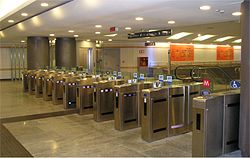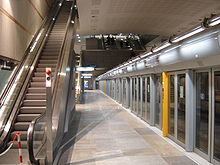- Turin Metro
-
Metrotorino 

Info Locale Turin Transit type Rapid transit Number of lines 1 Number of stations 21 Daily ridership 90,000 [1] (2010)[2] Operation Began operation 4 February 2006 Operator(s) Gruppo Torinese Trasporti Number of vehicles 58 (2009) [3][2] Train length 52 m (171 ft) Headway 2 minutes Technical Average speed 32 km/h (20 mph) System map The Metropolitana di Torino (Turin Metro) is a VAL metro system connecting Turin city centre, Italy, with the neighbouring city of Collegno. It is operated by Gruppo Torinese Trasporti (GTT), a public company controlled by the municipality of Turin. At present, the system comprises one line with 21 stations which connects Fermi station in Collegno with the Lingotto multifunctional centre in Turin.
First part of the line was opened on 4 February 2006 before the 2006 Winter Olympics; the second section connecting Porta Susa railway station to Porta Nuova opened on 5 October 2007, and the last part, between Porta Nuova and Lingotto opened on 6 March 2011.
Contents
History
The history of metro in Turin begins in 1930s, when the first project of an underground railway was put forward. However, only a part of the first underground tunnel was built, and the actual project was put aside. Nowadays, the tunnel is part of an underground parking system.
A new company committed to the development of a metro system in Turin was founded in 1960s. Several projects and feasibility studies were made for a 7 km underground line under the city centre and then for a line connecting FIAT factories to surrounding neighborhoods, but eventually all the proposals were rejected.
In the mid-80s a new proposal for a system of 5 fast tram lines at-grade was approved. However, only the planned line 3 was built following the original project, while the others eventually were built either as regular tram lines, with no dedicated lane, or as bus lines.
A new project was approved in 1995 for a line running from Campo Volo on the west border of the city to Porta Nuova, the main railway station in Turin. The project was put in hold due to lack of funds.
The project for the underground line was resumed in April 1999 with a longer route to Lingotto based on the VAL system. Works on the line began on 19 December 2000, part of the works for the Turin 2006 Winter Olympics. The first section from Fermi to XVIII Dicembre was opened on 4 February 2006, while the second section on the south to Porta Nuova opened on 5 October 2007. Porta Susa station opened later on 9 September 2011.
The last part of the line on the south to Lingotto was inaugurated on 6 March 2011.[4]
Ticketing
The single journey ticket costs 1€ and is valid also outside of the metro for unlimited trips on other public transport in the city for 70 minutes.[5]
Moreover, any form of urban transport season ticket is valid also for the metro system.[5]
Timetable
Turin Metro - Line 1Turin metro starts operations at 5:30 from monday to saturday (at 7:00 on sundays) and closes at 23:50. There is a service extension in weekends, when the metro closes at 1:30.[6]
Future plans
Line 1
Two additional stations are planned to reach the Southern boundary of the city, under Piazza Bengasi. Construction of this southern extension will not be completed until 2013.
A further Western extension is planned to reach the boundaries of Collegno and reach Cascine Vica district in the city of Rivoli. The plan comprises four additional stations, included Collegno FS which will interchange with the central railway station of the city of Collegno.[7]
Line 2
A second line is currently under planning. The line will connect South-Western suburbs of the city (Orbassano and Beinasco) with northern district of Barriera di Milano. First 26 stations are already defined, starting from Mirafiori Sud district to Barriera di Milano, crossing the Line 1 at Re Umberto station and serving key points as Politecnico di Torino University and Piazza Castello, one of the major central squares of the city.
Part of the Southern track will be elevated to reduce building costs (starting from Piazza Cattaneo to Cimitero Sud. On Northern side, from Vanchiglia to Rebaudengo, it will follow an old (currently abandoned) railway track, which was used to connect the old and abandoned scalo Vanchiglia to the main Turin railway.
A 4 stations extension is planned to cover suburbs of Beinasco and Orbassano and to reach terminus Pasta di Rivalta in the city of Rivalta di Torino.
List of planned stations of the Turin Metro Line 2 - Pasta di Rivalta
- Orbassano Centro
- Beinasco Centro
- Fornaci
- Cimitero Parco
- Fiat Mirafiori
- Cattaneo
- Omero
- Pitagora
- Parco Rignon
- Santa Rita
- Gessi
- Largo Orbassano - Zappata FS
- Caboto
- Politecnico di Torino
- Stati Uniti
- Re Umberto - M1
- Solferino
- Castello
- Regina Margherita
- Verona
- Novara
- Regio Parco
- Zanella
- Tabacchi
- Cherubini
- Paisiello
- Giulio Cesare
- Vercelli
- Rebaudengo FS
See also
References
- ^ "Da domenica la metropolitana arriva fino al Lingotto". La Repubblica. http://torino.repubblica.it/cronaca/2011/03/02/news/da_domenica_la_metropolitana_arriva_fino_al_lingotto-13094466/index.html?ref=search. Retrieved 25 September 2011.
- ^ a b Before the extension to Lingotto
- ^ "Servizi". GTT. http://www.comune.torino.it/gtt/gruppo/bil_sost/04_servizi.pdf. Retrieved 25 September 2011.
- ^ "Metropolitana Torino fino al Lingotto, inaugurazione 6 marzo con tratte gratuite e feste di via". Eco di Torino. http://www.ecoditorino.org/metropolitana-torino-fino-al-lingotto-inaugurazione-6-marzo-con-tratte-gratuite-e-feste-di-via.htm. Retrieved 26 February 2011.
- ^ a b "I biglietti". GTT Torino. http://www.comune.torino.it/gtt/urbana/metropolitana.shtml#biglietti. Retrieved 25 September 2011.
- ^ "Gli orari". GTT Torino. http://www.comune.torino.it/gtt/urbana/metropolitana.shtml#orari. Retrieved 25 September 2011.
- ^ "Turin Metro: Line 1". Infra.To. http://www.infrato.it/en/line1-link-1/ex/. Retrieved 25 September 2011.
External links
- Official GTT Website (Italian)
- Turin Metro Infrastructure
- Metrotorino at UrbanRail.Net
- Metrotorino at metros.hu (Hungarian)
- Photos
- Site with information and picture of Metrotorino (Italian)
 Urban public transport networks and systems in Italy
Urban public transport networks and systems in ItalyCommuter rail 
Rapid transit Trams Bergamo–Albino · Cagliari · Florence · Messina · Mestre (Venice) · Milan · Milan–Desio · Milan–Limbiate · Naples · Padua · Rome · Sassari · Turin · Trieste–OpicinaTrolleybuses Ancona · Bologna · Cagliari · Chieti · Genoa · La Spezia · Milan · Modena · Naples · Parma · Rimini–Riccione · Rome · SanremoPeople movers Categories:- Turin Metro
- 2006 establishments in Italy
- VAL people movers
- Railway lines opened in 2006
- Urban people mover systems
Wikimedia Foundation. 2010.



